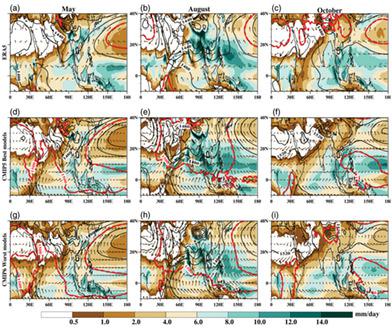当前位置:
X-MOL 学术
›
Int. J. Climatol.
›
论文详情
Our official English website, www.x-mol.net, welcomes your feedback! (Note: you will need to create a separate account there.)
An evaluation of CMIP5 and CMIP6 climate models in simulating summer rainfall in the Southeast Asian monsoon domain
International Journal of Climatology ( IF 3.9 ) Pub Date : 2021-07-12 , DOI: 10.1002/joc.7296 Dibesh Khadka 1 , Mukand S. Babel 1 , Abayomi A. Abatan 2 , Matthew Collins 2
International Journal of Climatology ( IF 3.9 ) Pub Date : 2021-07-12 , DOI: 10.1002/joc.7296 Dibesh Khadka 1 , Mukand S. Babel 1 , Abayomi A. Abatan 2 , Matthew Collins 2
Affiliation

|
In this study, 28 climate models from the fifth phase of the Coupled Model Intercomparison Project (CMIP5) and 32 models from the sixth phase (CMIP6) have been evaluated for their ability to simulate large-scale atmospheric circulations (using rainfall, wind fields, geopotential height, temperature, and moisture flux convergence) for the summer monsoon in Southeast Asia. Using a multi-criteria decision making technique, models have been ranked based on 25 metrics which compare their performances with observation data. Results indicate a better representation of annual rainfall cycles as well as spatial pattern by CMIP6 models compared to CMIP5. Though majority of the models from both CMIPs show late onset and early retreat of the rainy season, CMIP6 GCMs simulate the onset, retreat, and the length of the rainy season closer to the observation. Large-scale circulation patterns evaluated using spatial correlation and root mean square error (RMSE) show improvements in CMIP6 across all metrics, especially for the moisture flux convergence. Performances for large-scale circulation are generally reflected in rainfall simulation; however, few models showed that better simulations of rainfall do not exclusively depend on their performance for large-scale variables. Overall, CMIP6 models are found to be superior to CMIP5 models in simulating rainfall and large-scale circulation, which is likely attributable to CMIP6 model's higher spatial resolutions, increased number of vertical levels, improved atmospheric and land surface parameterization, etc. Finally, subsets of optimal models from CMIP5 and CMIP6 that proved to be better at representing the summer monsoons in the study area are identified. These models are recommended to develop robust future projections that can be used for climate change impact and adaptation studies.
中文翻译:

CMIP5和CMIP6气候模式模拟东南亚季风域夏季降雨的评价
本研究评估了耦合模式比对项目 (CMIP5) 第五阶段的 28 个气候模式和第六阶段 (CMIP6) 的 32 个模式模拟大尺度大气环流(使用降雨、风场、东南亚夏季风的位势高度、温度和水分通量辐合)。使用多标准决策技术,模型已根据 25 个指标进行排名,这些指标将其性能与观察数据进行比较。结果表明,与 CMIP5 相比,CMIP6 模型更好地表示了年降雨周期和空间格局。虽然来自两个 CMIP 的大多数模型都显示了雨季的迟发和早退,但 CMIP6 GCM 模拟了更接近观测的雨季的起止和长度。使用空间相关性和均方根误差 (RMSE) 评估的大规模环流模式显示 CMIP6 在所有指标上都有所改进,尤其是在水分通量收敛方面。大尺度环流的性能一般体现在降雨模拟上;然而,很少有模型表明,更好的降雨模拟并不完全取决于它们对大尺度变量的表现。总体而言,CMIP6 模型在模拟降雨和大尺度环流方面优于 CMIP5 模型,这可能归因于 CMIP6 模型更高的空间分辨率、增加的垂直层数、改进的大气和地表参数化等。最后,确定了 CMIP5 和 CMIP6 的最佳模型子集,这些模型被证明更能代表研究区域的夏季风。建议使用这些模型来开发可用于气候变化影响和适应研究的稳健的未来预测。
更新日期:2021-07-12
中文翻译:

CMIP5和CMIP6气候模式模拟东南亚季风域夏季降雨的评价
本研究评估了耦合模式比对项目 (CMIP5) 第五阶段的 28 个气候模式和第六阶段 (CMIP6) 的 32 个模式模拟大尺度大气环流(使用降雨、风场、东南亚夏季风的位势高度、温度和水分通量辐合)。使用多标准决策技术,模型已根据 25 个指标进行排名,这些指标将其性能与观察数据进行比较。结果表明,与 CMIP5 相比,CMIP6 模型更好地表示了年降雨周期和空间格局。虽然来自两个 CMIP 的大多数模型都显示了雨季的迟发和早退,但 CMIP6 GCM 模拟了更接近观测的雨季的起止和长度。使用空间相关性和均方根误差 (RMSE) 评估的大规模环流模式显示 CMIP6 在所有指标上都有所改进,尤其是在水分通量收敛方面。大尺度环流的性能一般体现在降雨模拟上;然而,很少有模型表明,更好的降雨模拟并不完全取决于它们对大尺度变量的表现。总体而言,CMIP6 模型在模拟降雨和大尺度环流方面优于 CMIP5 模型,这可能归因于 CMIP6 模型更高的空间分辨率、增加的垂直层数、改进的大气和地表参数化等。最后,确定了 CMIP5 和 CMIP6 的最佳模型子集,这些模型被证明更能代表研究区域的夏季风。建议使用这些模型来开发可用于气候变化影响和适应研究的稳健的未来预测。



























 京公网安备 11010802027423号
京公网安备 11010802027423号